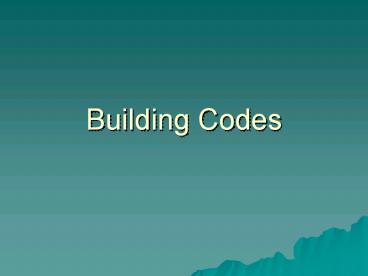Building Codes - PowerPoint PPT Presentation
1 / 18
Title:
Building Codes
Description:
Building Codes Codes Building Code Regional BOCA, SBCCI, CABO, UBC, CITY OF DALLAS, National IBC Fire Code NFC, UFC, NFPA, Life Safety 101 Accessibility Code ADAAG ... – PowerPoint PPT presentation
Number of Views:1484
Avg rating:3.0/5.0
Title: Building Codes
1
Building Codes
2
Codes
- Building Code
- Regional
- BOCA, SBCCI, CABO, UBC, CITY OF DALLAS,
- National
- IBC
- Fire Code
- NFC, UFC, NFPA, Life Safety 101
- Accessibility Code
- ADAAG, UDAG, TAS
3
Codes
- Zoning
- By region
- City of Lubbock Zoning Ordinance
- Specialty Codes
- TDH, TDHS, Long Term Care, Assisted Living
Facilities, Licensed Child-Care Center, Etc.
4
Codes
- Legal documents
- Must be adopted by region
- State, County, City
- Regional addenda
- Updated typically every 3 years
- IBC 2000, 2003, 2006
- Codes are written by experts in the field
- Architect, engineers, fire marshals,
manufacturers, contractor, end users
5
Codes
- Defined by historical events
- Human abuse/ life loss produces change in code
- Industrial revolution
- Coconut Grove fire
- Nursing Homes in the 60s
- Inaccessible facilities in the 80s
- 911/ Twin Towers, etc.
- Most codes allow for public review and submittal
6
Why Codes
- To protect health, safety and welfare
- Protect people not structures
- Establish a minimum standard
- Few codes mandate aesthetics
- Standard for design, permits, and construction
- Used by architects, engineers, contractors,
owners, code officials, lawyers
7
Architects Role
- Review all applicable codes
- Ensure code compliance
- Design, not construction
- Coordinate all consultants
- Consultants are responsible for their
disciplines, but architect is responsible for the
entire project, including all disciplines - Owner/Architect
- Architect/Consultants
- Review of codes with authorities
- Owner through contractor is responsible for
permits
8
Building Codes
- No national standard
- The International Code
- (23 states have adopted)
- Building, Fire, Residential, Electrical,
Mechanical, Energy, Plumbing, etc. - The City of Lubbock
- 2003 International Codes
- IBC, IPC, IFC, etc.
9
IBC Big Picture
- 1 - Occupancy
- Stated by project
- Chapter 3
- Group Classification
- Incidental Use
- Mixed Use
- Chapter 4
- Special Use
10
IBC Big Picture
- 2 Construction Type
- Chapter 6
- Non linear process between Construction Type and
Area Allowance - Type I most fire resistant non combustible
- Type II non combustible
- Type III composite
- Type IV heavy timber
- Type V least fire resistive
- The higher the type, the more expensive
11
IBC Big Picture
- Begin with the lowest Construction Type as
possible or Construction Type by material
selection - Typical residential, wood frame, Type IV
- Typical commercial, metal stud, Type II/ Type III
- Typical high-rise construction, Type I
- Fire resistive construction
- A non-combustible
- B combustible
- Differentiates fire rating of building elements
- Table 601
- Hidden elements such as blocking
12
IBC Big Picture
- Fire separation
- Distance to property line or another structure
- Table 602
13
IBC Big Picture
- 3 Area and Height Allowance
- Non linear process with Construction Type
- Table 503
- Area modifications per GSF
- Section 506
- Increase due to frontage or sprinkler
- Special Provisions
14
How to do a Code Study
- Non linear process
- Between area and construction type
- Between individual chapters and occupancy type
- Between individual chapters and Fire Resistance
Rated Construction - Chapter 7
- Fire wall, fire partitions, openings, etc.
- Note what applies to building only
15
How to do a Code Study
- Print 8 ½ x 11 of site and floor plan
- 6 Basic Steps
- Step 1 Classify Building
- Occupancy
- Construction
- Location
- Allowable Area and Height
16
How to do a Code Study
- Step 2 Review Occupancy Requirements
- Chapter 3
- Chapter 4
- Step 3 Review Construction Type and Fire
Resistance - Chapter 6
- Chapter 7
17
How to do a Code Study
- Step 4 Review Means of Egress
- Chapter 10
- Various calculations are required
- Occupancy load Table 1004.1.2
- NSF - do not have to calculate non occupied
spaces, corridors, walls, or restrooms - Exit width Table 1005.1
- Step 5 Review Accessibility
- Chapter 11
- Many regions submit to the authority of the
state - TDLR - Texas Department of Licensing and
Regulation - TAS - Texas Accessibility Standards
18
How to do a Code Study
- Step 6 Review Detailed Regulations
- All other chapters
- As they apply to building
- Have interior finishes, better look at Chapter 8
and Chapter 12 - Have plumbing, better look at Chapter 29
- Got glass Chapter 24































